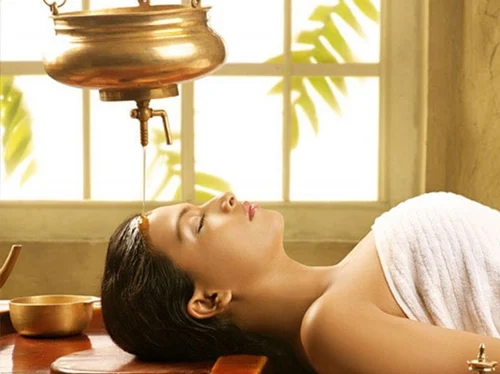Shirodhara Process and Benefits
Shirodhara is an ancient Ayurvedic therapy with remarkable benefits for both the body and mind. This treatment, practiced in India for thousands of years, is part of Ayurveda’s holistic approach to health and healing. The main goal of Shirodhara is to balance the doshas and create harmony between the body, mind, and spirit.
During the process, warm herbal oil or another medicated liquid flows steadily onto the forehead, particularly over the “third eye” area. This gentle stream calms the nervous system, reduces stress, and promotes mental clarity. Unlike many modern therapies, Shirodhara not only helps with relaxation but also assists in removing ama (stagnant toxins) from the body. The experience is often compared to meditation, as it brings deep peace and balance.
What is Shirobasti?
While Shirodhara involves a steady stream of liquid on the forehead, Shirobasti is a more intensive therapy. In Shirobasti, a leather or cloth cap is placed on the head and filled with warm medicated oil. The oil is retained for a certain duration, allowing deeper penetration.
This therapy is especially recommended for conditions such as:
-
Neurological disorders
-
Chronic insomnia
-
Severe migraines
-
Hair loss or premature greying
Because of its intensity, Shirobasti is always performed under expert supervision.
Different Types of Shirodhara Massage
Shirodhara is not a one-size-fits-all therapy. Ayurvedic practitioners select the liquid depending on the patient’s constitution and dosha imbalance. Each type has its own therapeutic value:
(A) Taila Dhara (Thaila Dhara)
In this method, herbal oils are mixed with extracts or essential oils. It is primarily recommended for balancing Vata dosha, which controls movement, circulation, and the nervous system. People suffering from anxiety, dryness, or restlessness often find great relief through Taila Dhara.
(B) Dugdha Dhara (Ksheerdhara)
Here, medicated milk infused with herbs is used. The cool, soothing quality of milk makes this therapy highly effective for Vata and Pitta imbalances. It helps reduce headaches, stress, and anxiety while nourishing the body. Many patients also report improved sleep after undergoing Ksheerdhara.
(C) Takra Dhara (Thakradhara)
Buttermilk mixed with specific herbs is the main ingredient. This method is especially beneficial for Pitta dosha, which governs metabolism, heat, and digestion. Takra Dhara not only refreshes the mind but also helps regulate mood swings and maintains the body’s internal balance.
(D) Kwatha Dhara (Decoction Therapy)
In this form, herbal decoctions are prepared and poured over the forehead. It is recommended for Vata and Kapha imbalances. Depending on the diagnosed condition, different herbs are selected. Patients with respiratory issues, skin conditions, or sluggishness often benefit from Kwatha Dhara.
(E) Jala Dhara (Aqueous Formulation)
This variation generally uses coconut water. Its cooling nature makes it ideal for calming Pitta dosha. Apart from balancing internal heat, it provides a refreshing sensation and helps in stress-related conditions.
Benefits of Shirodhara Treatment
The popularity of Shirodhara has spread worldwide because of its wide-ranging benefits. Some of the most notable include:
-
Balances Vata and Pitta doshas
-
Reduces mental and physical fatigue
-
Relieves stress, anxiety, and mild depression
-
Promotes deep and restful sleep
-
Improves concentration and focus
-
Boosts blood circulation in the brain
-
Strengthens the body and mind
-
Clears nasal blockages and improves hearing
-
Provides relief from chronic headaches and migraines
-
Supports better digestion and elimination
In addition to these, many people experience an overall sense of rejuvenation. Regular sessions make the mind sharper and the body more resistant to stress.
Final Thoughts
Shirodhara is more than just a relaxation therapy; it is a holistic treatment that harmonizes the mind and body. Whether you are struggling with stress, sleep problems, or dosha imbalance, this Ayurvedic practice offers a natural solution.
With consistent practice under expert guidance, you can experience not only better health but also improved mental clarity and emotional balance. In today’s fast-paced lifestyle, therapies like Shirodhara remind us of the power of ancient wisdom in modern living.
** Note:This article is written for educational purposes based on Ayurvedic principles and traditional texts. For proper diagnosis and personalized treatment, please consult a qualified Ayurvedic practitioner or healthcare professional.
Ayurvedic Doctor | 15+ Years Experience | General Physician and Panchakarma Specialist
 Dr. Dinesh Kumar is a qualified Ayurvedic doctor with over 15 years of experience in holistic physician and Panchakarma therapies. He specializes in natural treatments for skin, orthopedic, and lifestyle-related issues.
Dr. Dinesh Kumar is a qualified Ayurvedic doctor with over 15 years of experience in holistic physician and Panchakarma therapies. He specializes in natural treatments for skin, orthopedic, and lifestyle-related issues.
Clinic: Devkalp Ayurveda | Website: devkalpayurveda.com Youtube: Online Practical Tutorial
FAQs about Shirodhara
What is Shirodhara?
In Shirodhara, the therapist gently pours warm herbal oils or other medicated liquids in a continuous stream over the forehead, particularly on the third eye area. It calms the mind, balances doshas, and relieves stress.
What are the types of Shirodhara?
There are five main types: Taila Dhara (herbal oil), Dugdha Dhara (medicated milk), Takra Dhara (buttermilk), Kwatha Dhara (herbal decoction), and Jala Dhara (coconut water).
What is Shirobasti?
Ayurvedic doctors use this therapy to treat neurological conditions, insomnia, migraines, and hair issues. In this process, they place a cap on the head and fill it with warm medicated oil.
Who can benefit from Shirodhara?
People suffering from stress, anxiety, chronic headaches, Vata-Pitta imbalance, or mental fatigue can benefit greatly. It is also useful for those struggling with insomnia.
Is Shirodhara safe for everyone?
Generally, it is safe, but people with fever, cold, or recent illness should avoid it. Women should not undergo Shirodhara during menstruation. Always consult a certified Ayurvedic practitioner before starting.
How many sessions are recommended?
A typical course ranges between 7 and 14 sessions, depending on the individual’s health condition and the doctor’s advice.
Some Important Related Link
-
You can also read our detailed guide on Agnikarma Process in Ayurveda”
-
“For related therapy tips, check our article on Ayurvedic Rejuvenation Therapy”
-
“If you want a complete detox plan, see our post on Panchakarma Therapy.”
- “if you want to know about marma therapy on marma threapy procedure“
